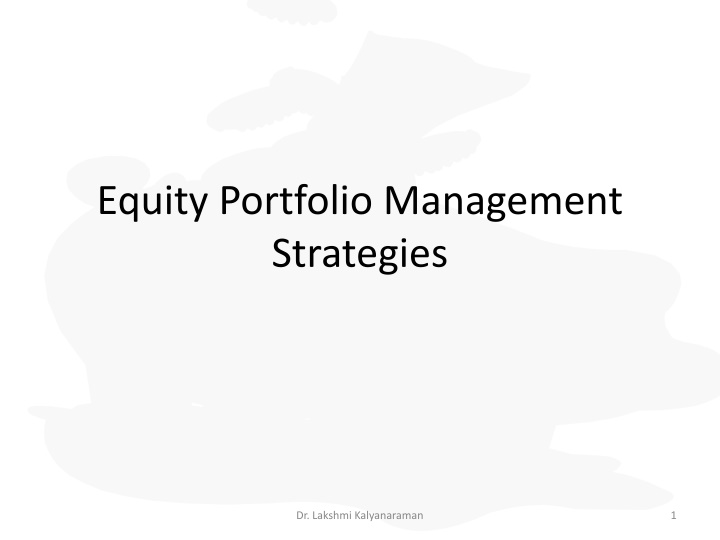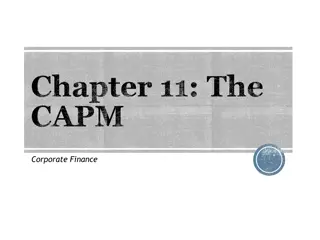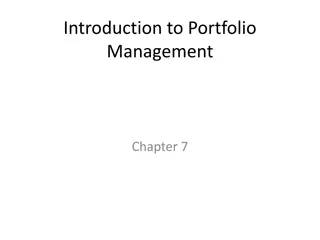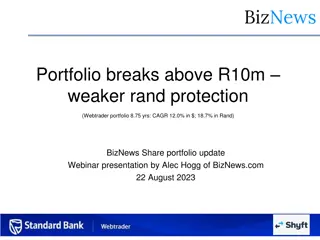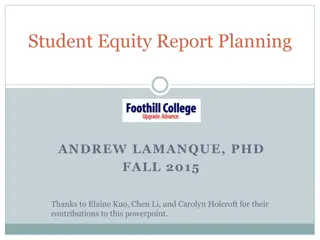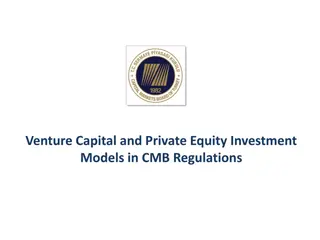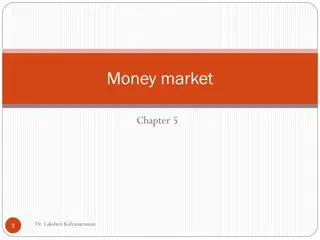Equity Portfolio Management Strategies by Dr. Lakshmi Kalyanaraman
Explore the world of equity portfolio management strategies through the expert insights provided by Dr. Lakshmi Kalyanaraman. Learn about constructing effective portfolios, analyzing market sectors, tactical asset allocation, and more to enhance wealth and make informed investment decisions.
Download Presentation

Please find below an Image/Link to download the presentation.
The content on the website is provided AS IS for your information and personal use only. It may not be sold, licensed, or shared on other websites without obtaining consent from the author.If you encounter any issues during the download, it is possible that the publisher has removed the file from their server.
You are allowed to download the files provided on this website for personal or commercial use, subject to the condition that they are used lawfully. All files are the property of their respective owners.
The content on the website is provided AS IS for your information and personal use only. It may not be sold, licensed, or shared on other websites without obtaining consent from the author.
E N D
Presentation Transcript
Equity Portfolio Management Strategies Dr. Lakshmi Kalyanaraman 1
Equity portfolio construction Managers analyse economy, industries and companies to estimate a stock s intrinsic value. Evaluate firms strategies and competitive advantage and recommend individual stocks for purchase or sale. Dr. Lakshmi Kalyanaraman 2
Equity portfolio construction Computers analyse relationships between stocks and market sectors to identify undervalued stocks. Dr. Lakshmi Kalyanaraman 3
Equity portfolio construction Managers of equity portfolios can increase investor s wealth through their sector and asset allocation decisions. Dr. Lakshmi Kalyanaraman 4
Tactical asset allocation A manager acting as a market timer might split his funds into two index portfolios: 1. stocks 2. bonds Benefits from correctly predicting broad market movements rather than trends for individual companies. Dr. Lakshmi Kalyanaraman 5
Insured asset allocation Attempts to limit investment losses by shifting funds between an existing equity portfolio and a risk-free security depending on changing market conditions. Dr. Lakshmi Kalyanaraman 6
Equity portfolio management strategies 1. Passive management 2. Active management One way to distinguish these strategies is to decompose the total actual return that the portfolio manager attempts to produce. Dr. Lakshmi Kalyanaraman 7
Equity portfolio management strategies Total Actual Return = Expected Return + Alpha Passive: Total Actual Return = [Risk-free rate + Risk premium] Active: Total Actual Return = [Risk-free rate + Risk premium] + [Alpha] Dr. Lakshmi Kalyanaraman 8
Passive portfolio managers Just try to capture the expected return consistent with the risk level of their portfolios. Dr. Lakshmi Kalyanaraman 9
Active portfolio managers Attempt to beat the market Form portfolio that can produce actual returns in excess of risk-adjusted expected returns Difference between actual and expected returns is called portfolio s alpha Dr. Lakshmi Kalyanaraman 10
Active portfolio managers Alpha represents the amount of value Added if positive Or subtracted if negative To the investment process. Dr. Lakshmi Kalyanaraman 11
Passive equity portfolio management Portfolio return will track those of a benchmark index over time. Indexing No attempt to generate alpha Dr. Lakshmi Kalyanaraman 12
Passive equity portfolio management Long-term buy and hold strategy Occasional rebalancing if the composition of the underlying benchmark changes cash distributions are to be reinvested. Dr. Lakshmi Kalyanaraman 13
Passive equity portfolio management Managers are judged by how well she tracks the target Minimizes the deviation between stock portfolio and index returns Dr. Lakshmi Kalyanaraman 14
Active equity portfolio management Attempts to outperform a passive benchmark portfolio on a risk-adjusted basis by seeking the alpha value Managers attempt to add alpha by 1. tactical adjustments (equity style or sector timing) 2. security selection (stock-picking) Dr. Lakshmi Kalyanaraman 15
PASSIVE EQUITY PORTFOLIO MANAGEMENT STRATEGIES Dr. Lakshmi Kalyanaraman 16
Passive management strategies 1. EFFICIENT MARKETS HYPOTHESIS Buy and hold Indexing Dr. Lakshmi Kalyanaraman 17
Passive Equity Portfolio Management Strategies Attempt to replicate the performance of an index Dr. Lakshmi Kalyanaraman 18
Passive Equity Portfolio Management Strategies Strong rationale for this approach Stock markets throughout the world are often fairly efficient Costs of active management (1 to 2%) are hard to overcome performance in risk-adjusted Dr. Lakshmi Kalyanaraman 19
Passive Equity Portfolio Management Strategies However, passive strategies are not costless to employ. Because of cash flows into and out of an index fund, as well as events that change the composition of the benchmark itself. May slightly underperform the target index due to fees and commissions Dr. Lakshmi Kalyanaraman 20
Index Portfolio Construction Techniques Full Replication All securities in the index are purchased in proportion to weights in the index This helps ensure close tracking Increases transaction costs, particularly with dividend reinvestment Dr. Lakshmi Kalyanaraman 21
Index Portfolio Construction Techniques Sampling Buys a representative sample of stocks in the benchmark index according to their weights in the index Fewer stocks means lower commissions Reinvestment of dividends is less difficult Will not track the index as closely, so there will be some tracking error Dr. Lakshmi Kalyanaraman 22
Index Portfolio Construction Techniques Quadratic Optimization (or programming techniques) Historical information on price changes and correlations between securities are input into a computer program composition of a portfolio that will minimize tracking error with the benchmark Relies on historical correlations, which may change over time, leading to failure to track the index that determines the Dr. Lakshmi Kalyanaraman 23
Tracking Error and Index Portfolio Construction The goal of the passive manager should be to minimize the portfolio s return volatility relative to the index, i.e., to minimize tracking error Dr. Lakshmi Kalyanaraman 24
Tracking Error and Index Portfolio Construction Tracking Error Measure Return differential in time period t t =Rpt Rbt where Rpt= return to the managed portfolio in Period t Rbt= return to the benchmark portfolio in Period t Tracking error is measured as the standard deviation of t, normally annualized (TE) Dr. Lakshmi Kalyanaraman 25
Tracking Error and Index Portfolio Construction Dr. Lakshmi Kalyanaraman 26
Methods of Index Portfolio Investing Index Funds In an indexed portfolio, the fund manager will typically attempt to replicate the composition of the particular index exactly The fund manager will buy the exact securities comprising the index in their exact weights Dr. Lakshmi Kalyanaraman 27
Methods of Index Portfolio Investing Index Funds Change those positions anytime the composition of the index itself is changed Low trading and management expense ratios Advantage: provide an inexpensive way for investors to acquire a diversified portfolio Dr. Lakshmi Kalyanaraman 28
Methods of Index Portfolio Investing ETFs Depository receipts that give investors a pro rata claim on the capital gains and cash flows of the securities that are held in deposit by a financial institution that issued the certificates Advantage of ETFs over index mutual funds is that they can be bought and sold (and short sold) like common stock Dr. Lakshmi Kalyanaraman 29
Methods of Index Portfolio Investing ETFs The notable example of ETFs Falcom Saudi Equity ETF HSBC Amanah Saudi 20 Falcom Petrochemical ETF Dr. Lakshmi Kalyanaraman 30
ACTIVE EQUITY PORTFOLIO MANAGEMENT STRATEGIES Dr. Lakshmi Kalyanaraman 31
Active Equity Portfolio Management Strategies 1. FUNDAMENTAL ANALYSIS a. Top down (asset class rotation, sector rotation, etc.) b. Bottom up (stock undervaluation / overvaluation) Dr. Lakshmi Kalyanaraman 32
Active Equity Portfolio Management Strategies 2. TECHNICAL ANALYSIS Contrarian (e.g. overreaction) Continuation (e.g. price momentum) Dr. Lakshmi Kalyanaraman 33
Active Equity Portfolio Management Strategies 3. ANOMALIES AND ATTRIBUTES a. Calendar effects ( e.g. weekend) b. Information effects ( e.g. neglect) c. Security characteristics ( e.g. P/E, P/B) d. Investment styles (e.g. value, growth) Dr. Lakshmi Kalyanaraman 34
Active Equity Portfolio Management Strategies Goal is to earn a portfolio return that exceeds the return of a passive benchmark portfolio, net of transaction costs, on a risk-adjusted basis Need to select an appropriate benchmark Dr. Lakshmi Kalyanaraman 35
Active Equity Portfolio Management Strategies Practical difficulties of active manager Transactions costs must be offset by superior performance vis- -vis the benchmark Higher risk-taking can also increase needed performance to beat the benchmark Dr. Lakshmi Kalyanaraman 36
Fundamental Strategies Top-Down versus Bottom-Up Approaches Top-Down Broad country and asset class allocations Sector allocation decisions Individual securities selection Dr. Lakshmi Kalyanaraman 37
Fundamental Strategies Top-Down versus Bottom-Up Approaches Bottom-Up Emphasizes the selection of securities without any initial market or sector analysis Form a portfolio of equities that can be purchased at a substantial discount to what his or her valuation model indicates they are worth Dr. Lakshmi Kalyanaraman 38
Fundamental Strategies Three Generic Themes Time the equity market by shifting funds into and out of stocks, bonds, and T-bills depending on broad market forecasts Shift funds among different equity sectors and industries (e.g., financial stocks, technology stocks) or among investment styles (e.g., value, growth large capitalization, small capitalization). This is basically the sector rotation strategy Do stock picking and look at individual issues in an attempt to find undervalued stocks Dr. Lakshmi Kalyanaraman 39
The Stock Market and the Business Cycle Dr. Lakshmi Kalyanaraman 40
Fundamental Strategies: The 130/30 Strategy Long positions up to 130% of the portfolio s original capital and short positions up to 30% Use of the short positions creates the leverage needed, increasing both risk and expected returns compared to the fund s benchmark Enable managers to make full use of their fundamental research to buy stocks they identify as undervalued as well as short those that are overvalued Dr. Lakshmi Kalyanaraman 41
Technical Strategies Contrarian Investment Strategy The belief that the best time to buy (sell) a stock is when the majority of other investors are the most bearish (bullish) about it The concept of mean reverting The overreaction hypothesis Dr. Lakshmi Kalyanaraman 42
Technical Strategies Price Momentum Strategy Focus on the trend of past prices alone and makes purchase accordingly Assume that recent trends in past prices will continue and sale decisions Dr. Lakshmi Kalyanaraman 43
Anomalies and Attributes Earnings Momentum Strategy Momentum is measured by the difference of actual EPS to the expected EPS Purchases stocks that have accelerating earnings and sells (or short sells) stocks with disappointing earnings Dr. Lakshmi Kalyanaraman 44
Anomalies and Attributes Calendar-Related Anomalies The Weekend Effect The January Effect Dr. Lakshmi Kalyanaraman 45
Anomalies and Attributes Firm-Specific Attributes Firm Size P/E and P/BV ratios Dr. Lakshmi Kalyanaraman 46
Investment Styles Value Versus Growth A growth investor focuses on the current and future economic story of a company, with less regard to share valuation Focus on EPS and its economic determinants Look for companies expected to have rapid EPS growth Dr. Lakshmi Kalyanaraman 47
Investment Styles Value Versus Growth Value investor focuses on share price in anticipation of a market correction and improving company fundamentals Value stocks generally have offered somewhat higher returns than growth stocks, but this does not occur with much consistency from one investment period to another Focus on the price component Not care much about current earnings Assume the P/E ratio is below its natural level Dr. Lakshmi Kalyanaraman 48
Style Analysis Construct a portfolio to capture one or more of the characteristics of equity securities Small-cap stocks, low-P/E stocks, etc Value stocks (those that appear to be under- priced according to various measures) Low Price/Book value or Price/Earnings ratios Growth stocks (above-average earnings per share increases) High P/E, possibly a price momentum strategy Dr. Lakshmi Kalyanaraman 49
Style Analysis Dr. Lakshmi Kalyanaraman 50
